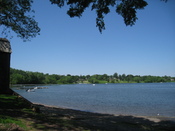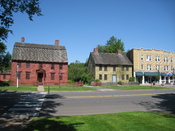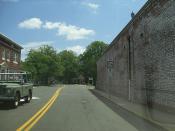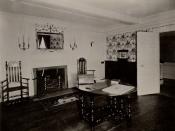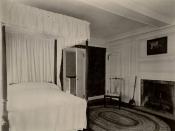The founder of the Connecticut colony, John Winthrop Jr., believed that some people must stay rich and some must remain poor. ConnecticutÃÂs erected their system of government on the proposition that the mass of mankind, the non-elect, was evil, corrupt and hardly fit for political participation. The data presented appears to corroborate the above. The religious forces overwhelmingly influenced Wethersfield making it more democratic during 1750 to 1780, offsetting the advances in other areas of society.
Between 1750 and 1780, the gap between the rich and the poor widened. The period understudy, 1750 to 1780, engulfs the seven years war. The war did bring riches to successful traders and brought depression and bankruptcy in the 1760s. Wethersfield was no exception. White males holding 100 acres or more was 5% in 1756 and increased to 15% by 1773. The same period saw the landless increase from 17% to 33%. 70% of all the taxable property was held by the top 30% of white males in 1756 and by 1776 the same 30% were the holders of 92% of all the taxable property.
Only 1.1% of taxable property was held by the lowest 30% of white males in 1756, which reduced to 0.2% by 1773. With added wealth, the top 30% of whites saw their average tax assessment go up from ã255 to ã263 when the average tax assessment of the lower 30% went down from ã4 to ã1. As evidenced by a chart of the wealthiest white males in Wethersfield, the wealth of the Chester family and the Buck family increased considerably whilst on that of the Belden family decreased by 10%. Few families rose to per eminence through trade, bringing the wares of the world to remote country villages. Houses of elegance sprang up between 1750 and 1775 as illustrated in Document E. Land was not only a livelihood àit became a commodity to be bought and sold for profit. The tax assessment of ã178 on the house of Joseph Webb seems large compound to the others. But it might be built on a bigger lot, necessitating a higher tax.
Politics in Wethersfield, which was almost proprietary in the 1750ÃÂs, turned more democratic by 1780. During 1751-1776, all offices were held by persons in the top 50% holding of assessed property. By 1771-1776, 13% of offices were held by persons whose assessed property holdings were in the lower 50%. Thus the representation of the economically poor increased during the period. The percent of adult white males able to meet foreman (voter) requirements increased only marginally from 65% to 67%. However there was more than 50% increase in the number of persons taking FreemanÃÂs oath and registering to vote, and actually voted. This shows increased participation of white males in politics during the period 1751-56 to 1771-76. This increased participation was rewarded with positions in town offices. The percent of white males elected to all town offices in 1751-56 was 32 and jumped to 52 in 1771-76. Aside from participation in the government, common people were actively involved in state affairs. In Jared IngersollÃÂs 1765 account of ÃÂThe Wethersfield AffairÃÂ in the Connecticut Gazette, Ingersoll provides evidence that the common peopleÃÂs defense declined in Wethersfield by 1765. He describes how a group of people threatened him and forced him to resign his position as a distributor of stamps for Connecticut, thereby subverting the Stamp Act.
On the religious front, the church was the state. The Congregational Church was the established church. No dissenting opinions were tolerated. Founded as an offshoot of the Massachusetts colony, the forefathers of the Connecticut believed that common man should not be in the government. This period, 1750-1780, covers the time immediately after the Great Awakening when the division between the old lights and the new light reached a climax. As Rev. James Lockwood, minister of the First Church of Chris, Wethersfield, preached in an election sermon before the Connecticut general assembly on May 9, 1754, ÃÂsome entrusted with authority ÃÂ subjection.ÃÂ The separatists were required to get the consent of the minister of the officially established congregational church in the local parish prior to arranging their sermons. Rev. Ebenezer Frothingman, a separatist minister, was jailed for preaching in Wethersfield without such permission. In the opinion of Rev. Frothingman ÃÂas a civil authority has no right to meddle with Ecclesial affairs. ÃÂ In his opinion, the government had no power to lock him up and it was the prejudice of the Congregationalists against the separatists. The two laws enacted by the Connecticut assembly in 1770, one to favor the Congregationalists and other to penalize the separatists states, ÃÂall ministers of gospel that now are ÃÂ estatesÃÂ and ÃÂno person in this colonyÃÂ incur any penalties...ÃÂ ÃÂTheir laws grind the poor and their religion is to oppress the oppressedÃÂ and pay three shillings for hut without a window in it. The best house and the richest man in the colony pay no more! The law is pretended to exempt Episcopalians, Anabaptists, Quakers and others, from paying rates to the Sober Dissenters [i.e. Congregationalists], but, at the same time, gives the Sober Dissenters power to tax them for minister, school, and town-rates by a general vote,ÃÂ comments Rev. Samuel Peters from England who visited Connecticut. Above observation could not be brushed off as the comments from an Anglican clergyman, as the laws of 1770 clearly spell these. In essence, the religious freedom was severely curtailed from 1750-1780.
Source: (DBQ) http://teachers.dphs.org/~mringer/Downloads/APUSH/DemocarcyinWethersfield.pdf
